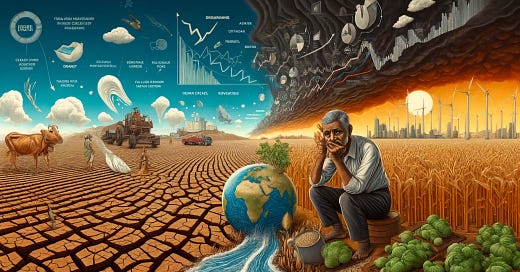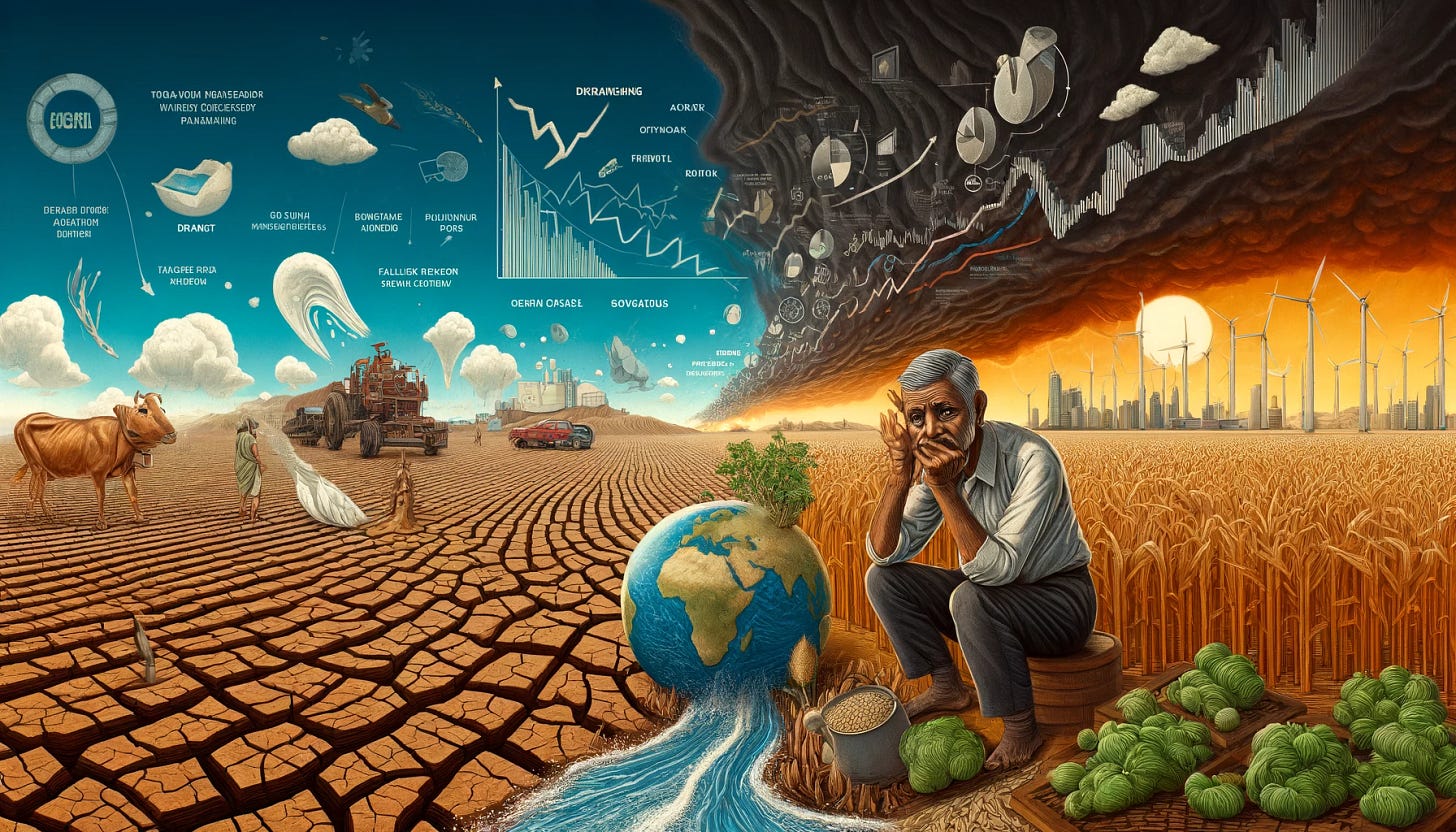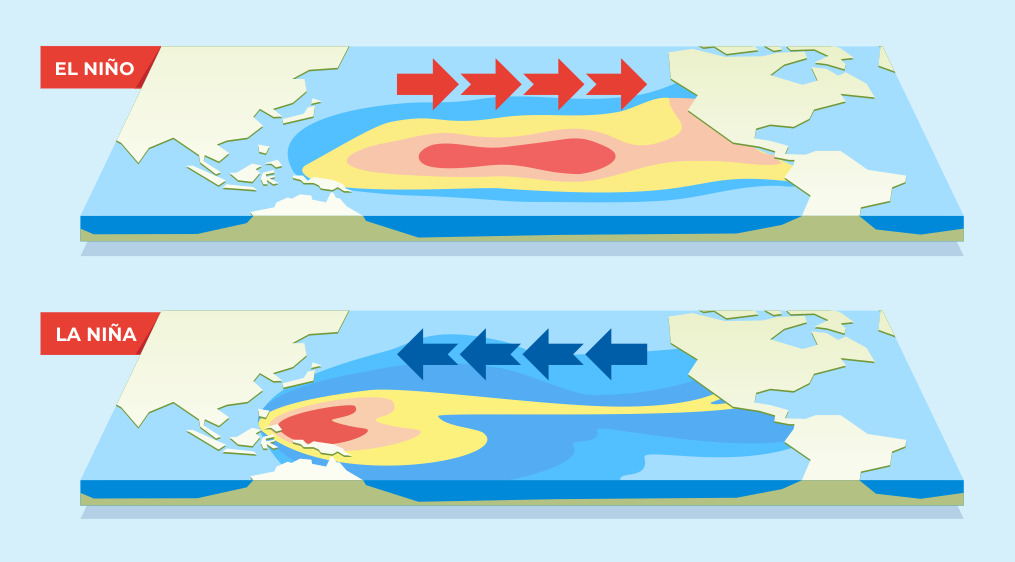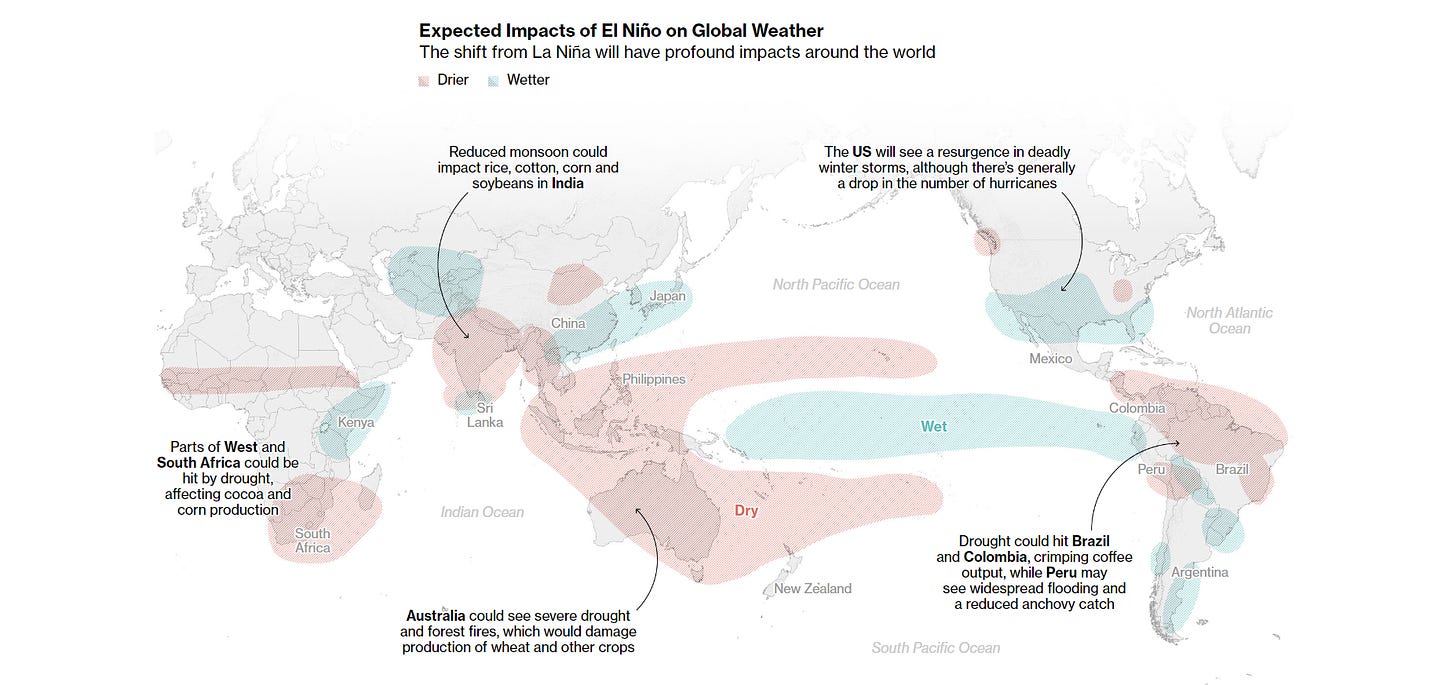El Niño Phenomenon: Impact on India's Agriculture, Economy, and Mitigation Strategies
Countries around the globe are intensifying their efforts to prepare for the impending onslaught of extreme weather as the world braces for the arrival of El Niño. The United States National Oceanic and Atmospheric Administration (NOAA) officially confirmed the onset of El Niño. However, scientists are expressing heightened concern regarding the upcoming El Niño. The last occurrence of a potent El Niño in 2016 resulted in the hottest year ever recorded and some reports blared that this El Niño event is projected to surpass the critical threshold of 1.5 degrees Celsius above pre-industrial levels outlined in the Paris Agreement.
What is El Nino Phenomenon?
El Nino is an intricate, large-scale ocean-atmosphere climate interaction that manifests as periodic warming of sea surface temperatures across the central and east-central Equatorial Pacific region. During a typical year, the Pacific experiences a consistent east-to-west flow of trade winds, which propel warm surface water towards the western Pacific, near Indonesia and Australia region. This natural phenomenon facilitates the upwelling process, wherein cold, nutrient-rich water from the deep ocean rises to the surface along the coast of South America.
However, the occurrence of an El Niño event disrupts this customary pattern. The trade winds weaken or even reverse, causing a disturbance in the natural flow. As a consequence, the warm surface waters, which are usually confined to the western Pacific, retreat eastward and accumulate along the coasts of South America. This alteration diminishes the upwelling of cold, nutrient-rich water, leading to a decrease in productivity within the coastal marine ecosystems. The impacts of El Niño extend well beyond the confines of the Pacific region.
Even prior to the onset of the recent El Niño event, global sea surface temperatures in May were found to be approximately 0.1°C higher than any previously recorded. This increase in temperatures has the potential to significantly impact weather patterns and intensify extreme weather events worldwide. During the winter season, it brings warmer weather conditions on the Indian subcontinent. Conversely, in the summer, it disrupts the monsoon season, leading to inadequate rainfall and drier conditions. These alterations in weather patterns can have significant implications for agricultural practices, water resources, and overall ecosystems.
El Nino impact on Agriculture Sector and India’s Economy:
El Niño has a profound impact on India's agricultural sector, particularly because a substantial portion of its farming practices still rely on rainfall. Around 50% of the country's net sown area is dependent on the monsoon rains, which not only irrigate the crops but also replenish water reservoirs. The summer monsoon season, occurring from June to September, contributes a significant 80% of the total annual rainfall, aligning perfectly with the main crop-growing season known as Kharif. This season plays a crucial role in the production of major crops like rice, pulses, oilseeds, cotton, and sugarcane. In regions with limited access to irrigation facilities, the dependence on a normal monsoon becomes even more pronounced.
Despite agriculture contributing only approximately 18% to India's Gross Value Added (GVA), it employs nearly half of the country's workforce (Niti Aayog, 2022). The decrease in rainfall caused by El Niño can lead to crop failure, water scarcity, inflation in food prices, reduced yields, and consequently, lower incomes for farmers, thereby affecting the livelihoods of millions of people. India's food security faces significant challenges during the wheat harvest, emphasizing the vulnerability of the agricultural sector to El Niño-induced disruptions.
India's inflation outlook could deteriorate further if there is an increase in global commodity prices. A study conducted by the International Monetary Fund (IMF) in 2016 reveals that the El Niño weather phenomenon has diverse economic impacts across different regions and can significantly influence global commodity prices, including crude oil. Countries such as Australia, a major wheat exporter, and Indonesia, a significant rice producer and palm oil exporter, experience adverse effects from El Niño, which can lead to higher food prices in international markets. Consequently, this could exert an adverse impact on inflation within India as well.
Several sectors, including FMCG, auto (two-wheelers, three-wheelers, and tractors), and agrochemicals, may experience the impact of subdued rural demand. Consequently, this could exert downward pressure on overall GDP growth. In the recent study published in the Science journal, the anticipated occurrence of El Niño, a climate pattern predicted to manifest in 2023, is projected to incur global losses amounting to $3 trillion by 2029. Moreover, the study highlights the potential for these losses to escalate significantly, reaching up to $84 trillion between the years 2020 and 2099.
El Nino and India’s past experience:
In the book "Late Victorian Holocausts" proposed the occurrence of severe famines in the late 19th century was closely linked to the El Niño phenomenon. The devastating impact of extreme weather conditions and disrupted monsoon circulation, extensively documented by British and Indian officials, among others, resulted in significant droughts and sporadic floods during the periods of 1876-78, 1896-97, and 1899-1900. These catastrophic events led to the loss of 30 to 60 million lives in India, China, and Brazil, while hundreds of millions endured widespread hunger, social upheaval, and political unrest. Although the detrimental effects of European colonialism and the proliferation of laissez-faire capitalism played crucial roles in exacerbating these calamities, the global teleconnections of El Niño and La Niña likely intensified the severity of droughts, crop failures, and malaria outbreaks.
“During the famine of 1899–1900, when 143,000 Beraris (Berar Province, Hyderabad) died directly from starvation, the province exported not only tens of thousands of bales of cotton but an incredible 747,000 bushels of grain. Despite heavy labor immigration into Berar in the 1890s, the population fell by 5 percent and “life expectation at birth” twice dipped into the 15 years range before finally falling to less than 10 years during the “extremely bad year” of 1900,” Mike Davis write in his book.
Shifting towards more recent timeframe, since 1950, India has experienced 21 El Niño years, coinciding with 15 drought events. Notably, 10 out of these 15 droughts were associated with El Niño occurrences. Analyzing historical data reveals that the probability of below-normal rainfall is nearly 70% during strong or moderate El Niño events, indicating a heightened risk of poor monsoon rainfall. However, it is important to note that not all El Niño years result in below-normal monsoons. Past data indicates that, despite El Niño conditions, southwest monsoon rainfall has been within the normal range due to favorable offsetting factors. These factors have contributed to the maintenance of adequate rainfall levels during the southwest monsoon season, even during El Niño years.
Overall, while El Niño events do pose a significant risk to rainfall patterns and drought occurrences in India, historical records demonstrate that other factors can counterbalance the influence of El Niño and maintain normal monsoon rainfall levels during the crucial southwest monsoon season.
To sum up, in order to mitigate the impact of El Niño, India can adopt effective solutions by implementing contingency plans at the district level. Initiating the introduction of late-sowing seed varieties that are better suited to withstand erractic rainfall patterns, focusing on water conservation and management, and monitoring the monsoon while preserving natural water bodies can significantly transform the agricultural industry and enhance its resilience in the face of challenges.
Furthermore, it is vital for government policymakers to develop protocols that reduce India's reliance on rainfall. For instance, Maharashtra and Karnataka, which collectively contribute 27 percent of the nation's sugarcane production, have already implemented regulations making the drip method of irrigation mandatory for sugarcane cultivation in their respective states.
By implementing such measures, India can bolster its agricultural sector and reduce its vulnerability to El Niño-induced droughts. These proactive steps, combined with innovative policies, have the potential to ensure a more sustainable and secure future for the country's agricultural landscape.







